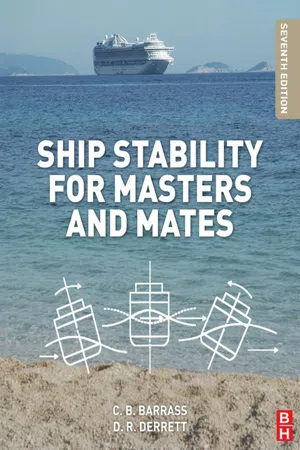
- 584 pages
- English
- ePUB (mobile friendly)
- Available on iOS & Android
Ship Stability for Masters and Mates
About this book
Ship Stability for Masters and Mates explores all aspects of ship stability and ship strength, squat, and interaction and trim, as well as materials stresses and forces. Organized into 56 chapters, the book looks at the relationship between ship stability and ship motion, with emphasis on group weights in a ship. It also explains how TPCs are calculated for a range of drafts extending beyond the light and loaded drafts, along with form coefficients, including the coefficient of fineness of the waterplane area.The book explains how to perform KB, BM, and KM calculations and make graphics on metacentric diagrams. It considers large-angle stability, the effect of beam and freeboard on stability, and hydrostatic curves and values for vessels that are initially on even keel. The reader is also introduced to free-surface effects of slack tanks with divisional bulkheads, how side winds affect ship stability, and the correlation between freeboard and stability curves. Other chapters focus on timber ship freeboard marks, procedures and calculations for drydocking and stability, and ship squat in open water and in confined channels. The book also includes extracts from the 1998 Merchant Shipping (Load Line) Regulations Number MSN 1752(M).This book is intended for students seeking to obtain Transport Certificates of Competency for Deck Officers and Engineering Officers and STCW equivalent International qualifications, as well as Chief Mates and Officers on Watch (Officers in Charge) on board merchant ships and other maritime personnel, port authorities, marine consultants, nautical study lecturers, and marine superintendents.- Updated throughout to include new shipping industry developments and regulations, with 9 new chapters, the latest ship stability datasheets, and sample exam questions- Provides a comprehensive introduction to all aspects of ship stability and ship strength, squat, interaction and trim, materials stresses and forces- Concepts are supported with numerous worked examples, clear diagrams, graphs and equations to assist with understanding and application of this critical subject
Frequently asked questions
- Essential is ideal for learners and professionals who enjoy exploring a wide range of subjects. Access the Essential Library with 800,000+ trusted titles and best-sellers across business, personal growth, and the humanities. Includes unlimited reading time and Standard Read Aloud voice.
- Complete: Perfect for advanced learners and researchers needing full, unrestricted access. Unlock 1.4M+ books across hundreds of subjects, including academic and specialized titles. The Complete Plan also includes advanced features like Premium Read Aloud and Research Assistant.
Please note we cannot support devices running on iOS 13 and Android 7 or earlier. Learn more about using the app.
Information
PART I
Linking Ship Stability and Ship Motions
Chapter 1
Group Weights, Water Draft, Air Draft, and Density
Group Weights in a Ship
Table of contents
- Cover image
- Title page
- Table of Contents
- Dedication
- Copyright
- Acknowledgments
- Preface
- Introduction
- PART I: Linking Ship Stability and Ship Motions
- PART II: Endnotes
- PART III: Appendices
- Index